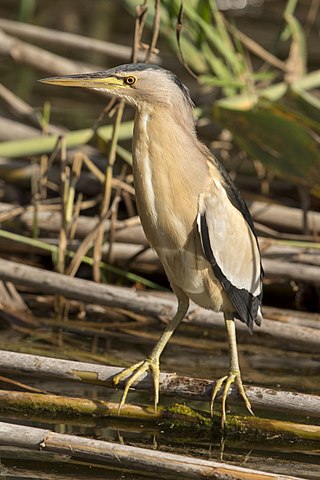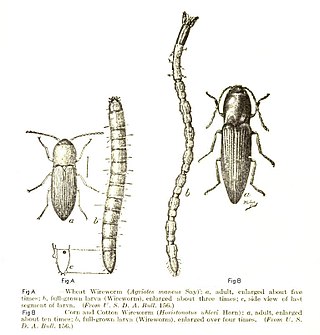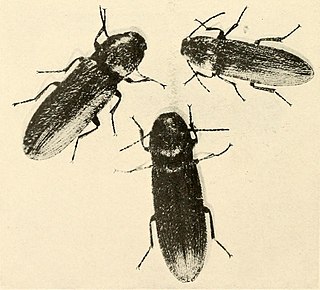
The little gull, is a species of gull belonging to the family Laridae which is mainly found in the Palearctic with some colonies in North America. It breeds on freshwaters and spends winters at sea. It is the smallest species of gull in the world and the only species in the monospecific genus Hydrocoloeus.

The little bittern or common little bittern is a wading bird in the heron family, Ardeidae. Ixobrychus is from Ancient Greek ixias, a reed-like plant and brukhomai 'to bellow', and minutus is Latin for 'small'.

The little curlew is a wader in the large bird family Scolopacidae. It is a very small curlew, which breeds in the far north of Siberia. It is closely related to the North American Eskimo curlew.

Elateridae or click beetles are a family of beetles. Other names include elaters, snapping beetles, spring beetles or skipjacks. This family was defined by William Elford Leach (1790–1836) in 1815. They are a cosmopolitan beetle family characterized by the unusual click mechanism they possess. There are a few other families of Elateroidea in which a few members have the same mechanism, but most elaterid subfamilies can click. A spine on the prosternum can be snapped into a corresponding notch on the mesosternum, producing a violent "click" that can bounce the beetle into the air. Clicking is mainly used to avoid predation, although it is also useful when the beetle is on its back and needs to right itself. There are about 9300 known species worldwide, and 965 valid species in North America.

The harvest mouse is a small rodent native to Europe and Asia. It is typically found in fields of cereal crops, such as wheat and oats, in reed beds and in other tall ground vegetation, such as long grass and hedgerows. It has reddish-brown fur with white underparts and a naked, highly prehensile tail, which it uses for climbing. It is the smallest European rodent; an adult may weigh as little as 4 grams (0.14 oz). It eats chiefly seeds and insects, but also nectar and fruit. Breeding nests are spherical constructions carefully woven from grass and attached to stems well above the ground.

The black noddy, also known as white-capped noddy, is a species of tern in the family Laridae. It is a medium-sized seabird with black plumage and a white cap that closely resembles the lesser noddy with which it was at one time considered conspecific. The black noddy has slightly darker plumage and dark rather than pale lores.

The Eurasian pygmy shrew, often known simply as the pygmy shrew, is a widespread shrew of the northern Palearctic.
Neacomys minutus, also known as the minute neacomys, the small bristly mouse, or the minute spiny mouse, is a rodent species from South America in the genus Neacomys. It is found in Brazil.

Clubul Sportiv Municipal Unirea Alba Iulia, commonly known as Unirea Alba Iulia, is a Romanian professional football club based in Alba Iulia, Alba County, founded in 1924 and currently playing in the Liga III.

The lesser tube-nosed bat is a species of megabat in the family Pteropodidae. It is native to two of the Maluku Islands in northern Indonesia.

The minute fruit bat is a species of megabat within the family Pteropodidae. It is found in Sumatra, Java, Borneo and Sulawesi. C. minutus is a smaller species that lives in rainforests. Continuous bimodal polyoestry has seasonal reproduction. The females of the species reproduce in synchrony, giving birth to offspring 5–7 months apart throughout two separate seasons. Postpartum oestrus occurs after each parturition. In C. minutus, both sexes reach sexual maturity at around 7 months, and females give birth for the first time at around 12 months. Females start having children not long after reaching sexual maturity, and they effectively continue having children indefinitely. Relative to other fruit bats, C. minutus have high rates of reproduction.
The Maspalomas bow-legged grasshopper is a species of grasshopper of the family Acrididae. The species is endemic to the town of Maspalomas on Gran Canaria Island, and is considered Critically endangered, or almost extinct, since it hasn't been found since 1949.

Limonius californicus, the sugarbeet wireworm, is a species of click beetle in the family Elateridae.

Limonius is a genus of click beetles in the family Elateridae. Many of the species formerly placed in this genus have been removed to other genera such as Gambrinus.

Limonius auripilis is a species of click beetle in the family Elateridae.
Limonius canus, the Pacific coast wireworm, is a species of click beetle in the family Elateridae. It is found in North America.
Limonius agonus, the eastern field wireworm, is a species of click beetle in the family Elateridae. It is found in North America.
Limonius subauratus, the Columbia basin wireworm, is a species of click beetle in the family Elateridae. It is found in North America.

Gobiraptor is a genus of oviraptorid maniraptoran dinosaur from the Maastrichtian-age Nemegt Formation of Mongolia. The type and only species is Gobiraptor minutus, known from a single incomplete specimen—the holotype MPC-D 102/111. It has been found not to be closely related to the other oviraptorids it shared its environment with.
Gambrinus is a genus of click beetles in the family Elateridae, most of which were formerly included in the genus Limonius.













